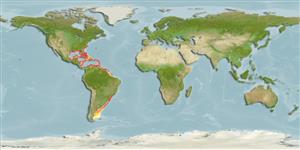Elasmobranchii (sharks and rays) >
Squaliformes (Bramble, sleeper and dogfish sharks) >
Squalidae (Dogfish sharks)
Etymology: Squalus: Genus name from Latin 'squalus' meaning shark (Ref. 6885, 27436).
Environment / Climate / Range
Ecology
Marine; demersal; depth range 60 - 400 m (Ref. 247). Subtropical, preferred ?; 36°N - 56°S, 97°W - 45°W (Ref. 54893)
Western Atlantic: North Carolina to Florida (USA), Gulf of Mexico, Cuba, Hispaniola; southern Brazil and Argentina.
Size / Weight / Age
Maturity: Lm ? range ? - 50 cm
Max length : 110 cm TL male/unsexed; (Ref. 247); common length : 75.0 cm TL male/unsexed; (Ref. 247)
A slim, gray shark with tips of dorsal fins black and edges of pectoral, pelvic and caudal fins white; two dorsal fins each with strong, ungrooved spine at front edge (Ref. 26938).
Inhabits continental shelves and uppermost slopes. Found in 60 to 380 m deep (Ref. 26938). Found on or near the bottom in large, dense schools. Probably feeds on bottom fishes and invertebrates. Ovoviviparous, with about 10 young per litter. A huge parasite (isopod) lives in its buccal cavity. Seldom used for food, but taken in commercial catches for its liver which yields oil and vitamins. Maximum depth reported taken from Ref. 55584.
Ovoviviparous, with about 10 young per litter (Ref. 247). Distinct pairing with embrace (Ref. 205).
Compagno, L.J.V., 1984. FAO Species Catalogue. Vol. 4. Sharks of the world. An annotated and illustrated catalogue of shark species known to date. Part 1 - Hexanchiformes to Lamniformes. FAO Fish. Synop. 125(4/1):1-249. Rome, FAO. (Ref. 247)
IUCN Red List Status (Ref. 115185)
CITES (Ref. 94142)
Not Evaluated
Threat to humans
Harmless
Human uses
Fisheries: minor commercial
More information
Age/SizeGrowthLength-weightLength-lengthLength-frequenciesMorphometricsMorphologyLarvaeLarval dynamicsRecruitmentAbundance
ReferencesAquacultureAquaculture profileStrainsGeneticsAllele frequenciesHeritabilityDiseasesProcessingMass conversion
Tools
Special reports
Download XML
Internet sources
